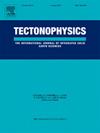增厚但成分浮力的西藏地幔岩石圈的重力不稳定性
IF 2.6
3区 地球科学
Q2 GEOCHEMISTRY & GEOPHYSICS
引用次数: 0
摘要
青藏高原是地球上主要的地形特征之一,它的演化、现在的构造和持续的地质活动给我们提出了许多悬而未决的问题。印度和欧亚大陆之间的大陆辐合在过去55myr持续至今,地壳的广泛增厚是由上地幔支撑的,在上地幔中,测量到的相对较快的剪切波速度可达200 千米甚至更深。虽然高原的高海拔主要归因于地壳的厚度,但观察到高原现在正在延伸,这证明岩石圈在增厚后增加了重力势能。在当前大陆碰撞期间,广泛的火山活动还意味着西藏岩石圈和/或上地幔被重新加热。在对流变薄过程中,地幔岩石圈被软流圈取代,这一过程被提出作为重新加热的一种解释,但这一过程很难与高原下上地幔测量到的高剪切波速度相协调。然而,一个基于在地幔上部200 千米的枯竭、交代的地幔岩石圈的有限翻转的模型可以调和这些明显矛盾的观测结果。这种反转可以解释观测到的地震速度分布是如何产生的,热量是如何注入岩石圈产生短暂的隆起的,以及地幔衍生的熔体是如何迅速到达整个高原广泛分布的地壳底部的。本文章由计算机程序翻译,如有差异,请以英文原文为准。
Gravitational instability of thickened yet compositionally buoyant Tibetan mantle lithosphere
The Tibetan plateau, one of the major topographic features of the Earth, presents many unanswered questions regarding its evolution, present structure, and continuing geological activity. The extensive crustal thickening that is attributed to continental convergence between India and Eurasia sustained for the past 55 Myr, and continuing today, is underlain by an upper mantle in which relatively fast shear-wave speeds are measured to depths of 200 km and more. Although the high elevation of the plateau can be attributed mainly to the thickness of the crust, the observation that the plateau is now extending is evidence that the lithosphere has increased its gravitational potential energy since it was thickened. Extensive volcanism during the current continental collision additionally implies that the lithosphere and/or uppermost mantle of Tibet was re-heated. Replacement of mantle lithosphere by asthenosphere in a convective thinning process has been advanced as an explanation of that re-heating, but that process has been difficult to reconcile with the high shear-wave velocities measured in the upper mantle beneath the plateau. However, a model based on a restricted overturn of a depleted, metasomatised, mantle lithosphere in the upper 200 km of the mantle can reconcile these apparently contradictory observations. Such overturn can explain how the observed distribution of seismic velocities has been produced, how heat is injected into the lithosphere producing transient uplift, and how mantle-derived melts can rapidly reach the base of the crust in widely distributed locations across the plateau.
求助全文
通过发布文献求助,成功后即可免费获取论文全文。
去求助
来源期刊

Tectonophysics
地学-地球化学与地球物理
CiteScore
4.90
自引率
6.90%
发文量
300
审稿时长
6 months
期刊介绍:
The prime focus of Tectonophysics will be high-impact original research and reviews in the fields of kinematics, structure, composition, and dynamics of the solid arth at all scales. Tectonophysics particularly encourages submission of papers based on the integration of a multitude of geophysical, geological, geochemical, geodynamic, and geotectonic methods
 求助内容:
求助内容: 应助结果提醒方式:
应助结果提醒方式:


